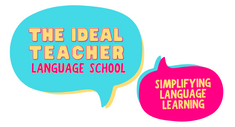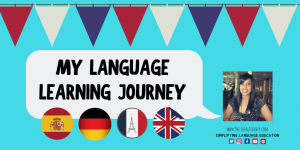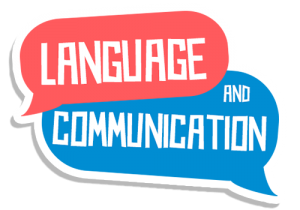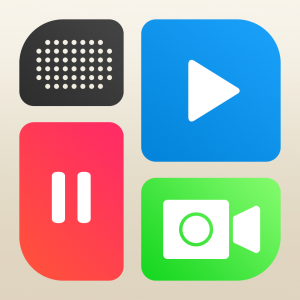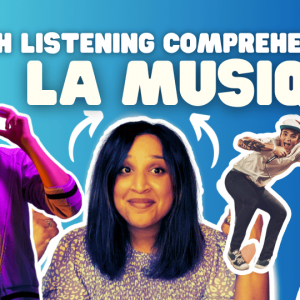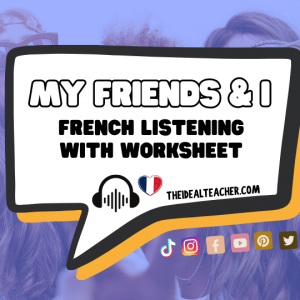How To Improve Your Speaking with Short Video Clips
Short video clips are fantastic prompts for spontaneous speaking practice when it comes to learning any language.
“Videos generate visual stimulants that wake up the brain cells and demand focused attention” which can be used to enhance the language learning process.
This post on using video clips for spontaneous speaking practice in language learning comes mainly from personal experience. Although “most teachers regard video as useful input” (Warwick University – Video For All).
So…read on to see how using short video clips helped me to overcome my fear of spontaneous speaking, and to see some great websites with excellent short video clips perfect for language learning.
 Long But (Hopefully) Interesting Background – Skip To The Bottom If You’re Not Really Here For My Life Story 🙂
Long But (Hopefully) Interesting Background – Skip To The Bottom If You’re Not Really Here For My Life Story 🙂
I started my German language learning journey when I was eleven years old in 1998. Although I went to a traditional Grammar School, I wasn’t particularly adept at most subjects. However, when I got 20/20 on a vocabulary test in an early German lesson, I was hooked. It was from then on that I knew that I wanted to do something with the German language when I was older. In fact, it was a similar situation when I started learning French with Mr Hutchings a year later. I always got 10/10 on vocabulary tests, knew the answers to listening comprehension questions and reading comprehension activities. In addition, I was always the first one to have my hand up when the teachers asked a question.
Unfortunately though, when it came to speaking, I consistently froze and couldn’t manage to get the words out… I clearly lacked confidence in speaking. Firstly, I was scared of making mistakes, as I am a perfectionist, and, secondly, to some degree, I don’t think we were given useful opportunities to speak in German lessons with effective feedback.
Sadly, my inability to speak continued into my GCSE and my A Level years. In fact, I vividly remember getting a D in my French AS Level speaking and crying on the phone to my parents when I told them my results outside the gates of my school.
So, How Did I Get Past The Fear of Speaking?
I was lucky enough that my parents could afford to send me off to a language school in Paris for a few weeks to immerse me in the language and culture of a French speaking country. Regrettably, this experience didn’t help me, as my fear of speaking worsened when I was put in front of native speakers! Despite this, I somehow managed to get the top grades in both my German and French A Level examinations. I was happy, but knew that I still had a deep-routed problem when it came to speaking.
 Language As A Communication Tool
Language As A Communication Tool
Language is defined as “the method of human communication” and according to research carried out by Burley-Allen (Flowerdew and Miller 2005:22-23) thirty-five percent of time is dedicated to speaking a language. Yet, I couldn’t actually communicate confidently in the languages that I loved so much…
In 2007, after nine years of being unable to speak German and French with any semblance of confidence, I decided that enough was enough. I had to overcome the irrational fear and enlisted the help of a native French teacher, who lived in Réunion Island with bi-weekly online conversation classes on iTalki and this was actually the best thing I could have done to aid me in my question to speak!
 Using Video Clips for Spontaneous Speaking in Language Learning
Using Video Clips for Spontaneous Speaking in Language Learning
I told my new French teacher that my goal was to become more confident in communicating in French and advised that my main focus was speaking. She used various activities for spontaneous speaking practice to try to break my fear of speaking. Each activity had some effect, as I began to feel my confidence growing. However, the one activity that really stood out and resonated with me, was when she used video clips as speaking prompts.
Many of us have had the experience of watching a video clip in a learning environment and not really knowing why we are watching it. After 10 minutes, at best, we become passive. However, the video clips she selected were usually six minutes or less and they really did ‘wake up the brain cells and demand focused attention’!
The short video clips were motivational and gave me an excellent prompt to allow me to express myself without any pressure. I particularly remember one video clip that was a hand drawn daily routine. Unfortunately, I can no longer find the link. But, if you are looking for a video to watch for ‘morning routines’, check out this 7-minute video clip : https://www.youtube.com/watch?v=v8ZXKP3VBHM.
How could you use video clips to get students speaking?
- You could get students to discuss with their partner what activities they think they will see before watching the video. Students could do this from the video clip’s title, but they must think of words, or discuss their thoughts in the language they are learning. Extra: Share their ideas with another pair.
- Give students time to make notes of their thoughts on a mini-whiteboard
- Thirdly, students watch the video and tick off the items they identified before watching on their mini-whiteboards
- Ask students to watch again and make notes of extra items
- After watching the video, pairs could work together to describe or summarise the activities that they saw in the ‘she’ form.
- Finally, students could work with another pair and take turns to describe the routine from the clip in order, but in the past tense.
With the new 9-1 language GCSE examinations (A Level), I do like the fact that students have speaking prompts in the form of photo cards. Video clips take this one step further and if they helped me towards feeling more confident in my speaking, I am sure they can help you and your students.
DISCLAIMER: I know that watching video clips isn’t going to make you a fluent speaker in itself. You still also need to broaden your vocabulary, understand how grammar affects the language, as well as work on listening skills. However, if you want a great spontaneous speaking activity to help you develop your verbal skills, you may find the video clips for spontaneous speaking prompts handout useful for your teaching practice, or as a resource to give to students for independent speaking practice. Links and details below. If you’re looking for a handy resource to give to your students download the short video clips for language learners here :
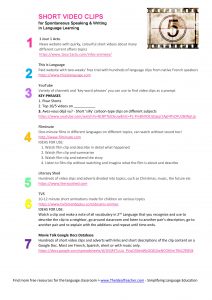
SHORT VIDEO CLIPS – For Spontaneous Speaking & Writing in Language Learning
1. 1 Jour 1 Actu
News website with quirky, colourful short videos about many different current affairs topics
https://www.1jour1actu.com/infos-animees/
2. This is Language
Paid website with two-weeks’ free trial with hundreds of language clips from native French speakers
https://www.thisislanguage.com
3. YouTube
Variety of channels and ‘key-word phrases’ you can use to find video clips as a prompt
KEY-PHRASES
1. Pixar Shorts
2. Top 10/5 videos on ___________
3. Avez-vous déjà vu? – Short ‘silly’ cartoon-type clips on different subjects
https://www.youtube.com/watch?v=8LNP7biDeuw&list=PL-PmBh9OEJjZsgqr1AgF4fvDFU2BiWgUp
4. Filminute
One-minute films in different languages on different topics, can watch without sound too!
http://www.filminute.com
IDEAS FOR USE:
1. Watch film clip and describe in detail what happened
2. Watch film clip and summarise
3. Watch film clip and extend the story
4. Listen to film clip without watching and imagine what the film is about and describe
5. Literacy Shed
Hundreds of video clips and adverts divided into topics, such as Christmas, music, the future etc
https://www.literacyshed.com
6. TV5
10-12 minute short animations made for children on various topics
https://www.tivi5mondeplus.com/dessins-animes
IDEAS FOR USE:
Watch a clip and make a note of all vocabulary in 2nd Language that you recognize and use to describe the clip to a neighbor, go around classroom and listen to another pair’s description, go to another pair and re-explain with the additions and repeat until time ends.
7. Movie Talk Google Docs Database
Hundreds of short video clips and adverts with links and short descriptions of the clip content on a Google Doc. Most are French, Spanish, silent or with music only.
https://docs.google.com/spreadsheets/d/1MjFKTuUu_fVwO30eJd9zGQliUIwNCO6VmT6kCZfI8V8
References:
Jurich, S. (1999) The Impact of Video Technology in Education: From Here to Where?
Walker, N. (2014) LISTENING: THE MOST DIFFICULT SKILL TO TEACH: Manchester Metropolitan University
Video for All (2014) Video as a Learning Resource, University of Warwick
JOIN ME ON MY SOCIALS FOR MORE FAB TEACHING CONTENT >>